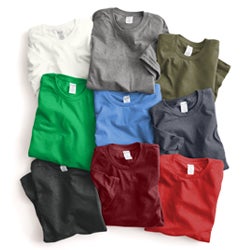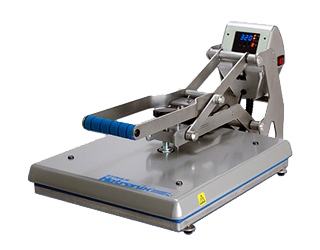Which Screen Printed Transfer Should I Use? Goof Proof vs Hot Split Retro
Browse Video Categories
Transfer Application | Artwork & Apparel | Easy View Tutorials | Webinars | Ordering Tips | Business | Heat Presses
We get asked frequently what the difference is between Goof Proof and Hot Split Retro screen printed transfers.
Which transfer should you order when?
In this video, Dave covers what each transfer is and when you would want to order each one.
-------------------------------------------
Hey friends! Dave, here, with Transfer Express and today we're covering a question we get asked all the time - what's the difference between our Goof Proof transfers and our Hot Split Retro.
So we're going to be diving into the differences and similarities between the two transfers themselves, how and why they apply differently, and we'll even cover some heat printing tips that could save you some frustration.
Are you ready? Let's learn something today!
First things first, we're talking about two different kinds of our screen printed transfers here at Transfer Express. Goof Proof is our number one best-selling product and for a good reason. As the easiest to apply screen printed transfer on the planet, it perfectly emulates the look and feel of a traditional plastisol ink print with outstanding durability and opacity on any color apparel, is an incredibly versatile product for apparel printing.
Now, our Hot Split Retro transfers are specifically formulated to mimic soft hand screen printing. This is achieved by using a higher heat and longer press time for a lightweight soft
print that almost melts into the fabric. They're great for prints on those lightweight or burnout garments. Now because of the lighter feel, some colors have reduced opacity especially when printing on darker colored garments which is exactly what we're going to do today.
So what makes our Hot Split and Goof Proof screen printed transfers different? While they do share the exact same plastisol ink formula, Hot Split Retro transfers do not receive the powdered adhesive. If you've used our Goof Proof transfers before, you may have noticed
the adhesive powder. It's what gives the transfer a sandpaper like feel before being applied. That adhesive is what makes our Goof Proof transfers easier to apply with a wide range of temperatures and press times, as low as 4 seconds.
Hot Split, on the other hand, has a smooth finish and feel on the inks while they're still on the carrier sheet, and without the adhesive, they require a higher heat and longer press time, effectively melting the inks into the fabric like we talked about. These transfers do demand more precise temperatures from your heat press for successful application.
So here we have the same artwork printed as both Hot Split and Goof Proof. Looking up close here can you tell which one's which? If you said Goof Proof on the right, you're correct. You can tell because it does have that little bit of the grit of that adhesive powder in the inks versus the smoother Hot Split Retro without the adhesive.
You may even notice some of the ink will stay on the carrier sheet after peeling and this is completely normal for Hot Split. It's actually how it got its name because the ink literally splits from the carrier sheet to the garment.
Enough about the technical specs, though. Let's fire up the heat press back here behind me and print some shirts. You'll see how similar the two applications could be with some slightly different results.
So let's set our press to 365°F for Goof Proof to start.
Goof Proof works great on 100% cotton, cotton poly blends, and 100% polyester. And it's great because of its versatility.
If you're printing on 100% polyester, you could use the lower application instructions at 325 degrees to reduce the chances of scorching those heat-sensitive polyester garments.
So here we're printing with some Next Level 3600s in black. This is a 100% cotton tee and one of my favorites for its fit, feel, and finish. It's also incredibly affordable, so that's the best part.
We're going to be printing with orange inks. They are the exact same ink color that we selected from Easy View online designer so we'll see how they print on the darker colored fabrics. So we're just going to take our shirt and we're going to thread it right on to our heat press here. And of course, we are using the Hotronix Auto Clam 16x20. This auto opens has a dual stage timer and a digital pressure readout, so we absolutely love this press. We'll just make sure that there are no seams and our garment is lying flat on our lower platen. You can even adjust each side to make sure that we're centered – and that looks perfect. Now, always a good tip to pre-press your garments. That's going to remove any moisture and wrinkles and give you a nice surface for a transfer to adhere to.
So let's pre-press it three to five seconds. The pre-press is also a great opportunity to make sure that your pressure is right. So I see the pressure is at a nine, which is a little bit heavy for what we're looking for today. So I'll just rotate our pressure knob a couple quarter turns counterclockwise and we'll see where our pressure's at now. Right in a seven, between that six to eight that is recommended for Goof Proof and Hot Split transfers. We're going to take our gang sheet. We're going to cut this bottom graphic off so we just have this full front. Now that we've got the Goof Proof all cut out and ready to go, our shirt is pre-pressed, our press is at temperature, let's go ahead and press our t-shirt now.
We'll just go ahead and lay our transfer down. Make sure that we're nice and centered up.
Our Goof Proof presses at 365 degrees for four to six seconds. It is a hot peel, so we'll peel the transfer carrier away immediately. Remove this one from the heat press.
Look at that. Look how great that looks. The Goof Proof inks a nice great screen printed t-shirt. That's the finished product.
Now let's do the same exact thing, same exact shirt, same exact inks, but with Hot Split this time. Hot Split Retro transfers are recommended for cotton, polyester, and cotton poly blends, like those burnout tees or 50/50 shirts.
However, you should take caution when printing high polyester content, as most polyester fabrics are heat sensitive and you may get some scorching on the fabric with that 360 to 370 degree press temperature.
So here, for our second application we'll take our Next Level 3600 and do the same exact thing that we did the last time. Now here, we'll go ahead and set our press temperature
to 370 degrees, and we'll bump the time up to 10 seconds. Now that's a lot more than the Goof Proof applied at, almost double the time.
You should always defer to what the instruction sheet says for you to print.
We'll do the same thing we did with the Goof Proof, but with our Hot Split transfer. We'll make sure we pre-press. We'll take our transfer just like the Goof Proof and we'll lay it on down right here onto our garment. Go ahead and press this one for 8 to 10 seconds. We're going to elect to go with 10 seconds today. Hot Split is a hot peel. There we go. We'll just peel it off the carrier immediately.
As you can see, a little bit of ink actually stays into the transfer here along with the stain. The pigments in the orange or red inks typically do stain the paper, but you can even see there are little tiny specks of ink that got held onto this transfer carrier.
We'll go ahead and pull our Hot Split shirt off of the press. We'll set them down here side by side so we could get a great comparison. Now here they are together, and I'm not sure if you're going to be able to see this on camera, but the Hot Split Retro here on the left hand side, is a little bit darker than the bright, opaque orange of the Goof Proof.
With the Hot Split on this side, you can pretty much feel the garment. You can feel the print a little bit, but it is barely there, whereas here on the Goof Proof side, it still is incredibly soft, but you could feel the print a little bit more noticeably than the Hot Split.
The real difference with feel comes on the inside of the garment. When you're wearing it, you could feel these lines and the thick text at the top you can feel through the shirt like a
typical screen printed shirt.
With the Hot Split, it is almost non-existent. You cannot feel the letters and that line. Only here, where there's a little bit thicker text that you could really feel the inside of the print.
Of course we have to talk about stretch and reboundability, so we'll just give the Hot Split a little tug. You can see that it stretches with the fabric very good. Now, we expect much more from the Goof Proof and that it actually stretches very, very good. Nice transfer adhesion there.
Thanks for watching guys! We hope today's video covered any questions you may have had about the differences in Hot Split and Goof Proof and which one of these transfer types is right for your next project. At Transfer Express, we are always happy to help, so be sure you like this video if you learned something today. It helps others find this video so they could learn, too, and comment below with any questions of your own or tips or differences that you've noticed pressing Hot Split and Goof Proof.
Make sure you're subscribed to stay up to date with weekly ideas, education and t-shirt business tips, to maximize your business's opportunities. We're releasing new videos like this one every single week. And until then, I'm Dave – happy pressing!



















